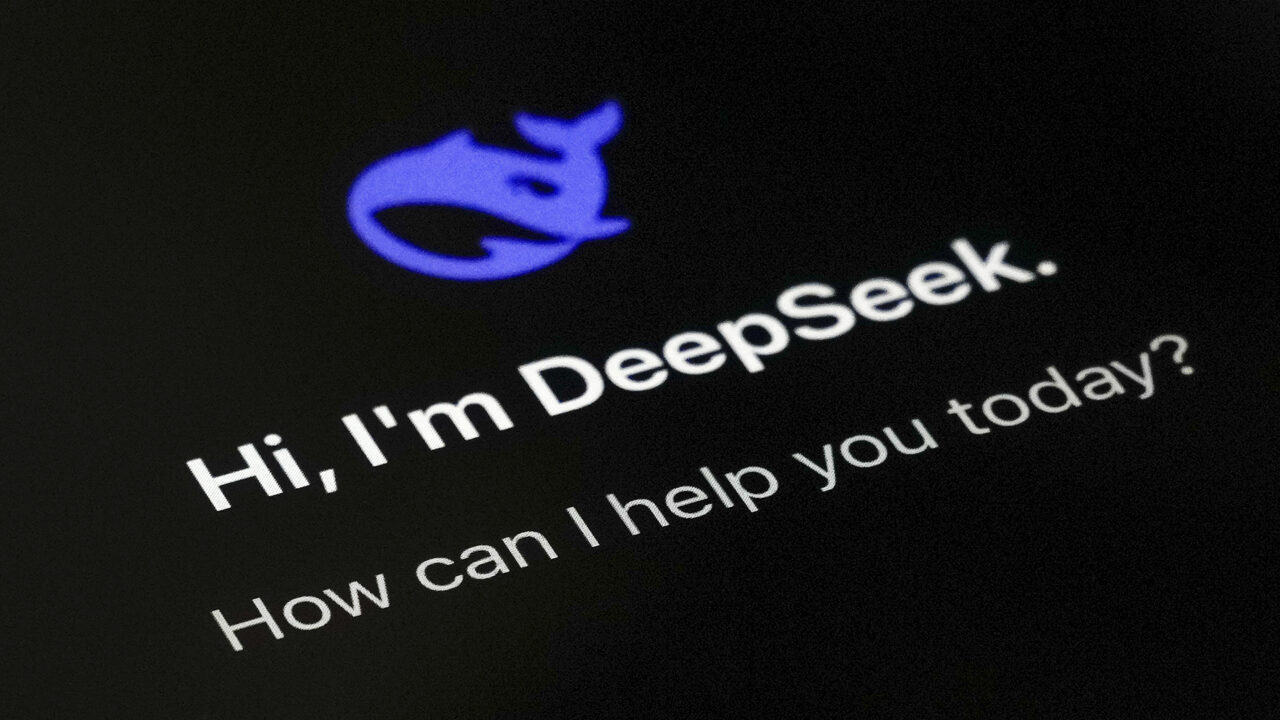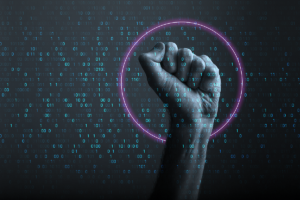Toward a People’s AI
DeepSeek isn’t fully “open source.” But the Chinese-made artificial intelligence does raise the question of what an AI, by and for the people, rather than corporations, might look like. A screenshot of the DeepSeek smartphone app. (AP Photo/Andy Wong)
A screenshot of the DeepSeek smartphone app. (AP Photo/Andy Wong)
On the day of Donald Trump’s inauguration, Chinese artificial intelligence company DeepSeek released an advanced reasoning model, DeepSeek-R1, that sent shockwaves throughout the world. The big news was, of course, that the company built a “frontier” — cutting edge — AI model that competes with the leading models in the United States. That includes OpenAI’s o1 series that incorporates “reasoning.”
Deemed America’s “Sputnik moment” by tech billionaire Marc Andreessen, the Chinese company had created China’s first groundbreaking tech innovation that will likely have Americans copying the Chinese, rather than the other way around.
This development has created a lot of confusion, especially for a news media marketplace defined by sensationalism and clickbait. For starters, the press falsely reported that DeepSeek spent only $5.6 million building the model, a number that initially spread like wildfire without critical investigation. In fact, the $5.6 million refers only to a small portion of the development process; the total cost plausibly exceeds $500 million over the company’s history. Nevertheless, it is true that DeepSeek released its model to the public for use at a very low price point.
Another inaccurate claim involved the extent to which DeepSeek is “open source.” This is wrong. According to the Open Source Initiative, an AI system meets the criteria “open source” if the system provides the freedom to use, study, modify and share the system. That’s the standard “open source” criteria over decades. For AI, this includes the “data information” (about the data used), the “code” used to train and run the system, and the model “parameters” (such as weights and configuration settings). DeepSeek discloses its model weights and architecture, but it does not release the data and code. That lack of disclosure “renders the application nonfree, since it is not possible to truly study or modify it,” Zoë Kooyman of the Free Software Foundation put it to me in an email. Nevertheless, the company’s disclosures go beyond what similar (mislabeled) “open source” models like Meta’s Llama disclose to the public, and they provide AI researchers with a reasonable enough means to make use of its innovations.
This opens a deeper discussion that has been missed pretty much across the board: What would a “people’s AI,” by and for the people, rather than corporations, look like? To answer that, we need to revisit the history of free and open source software.
The one who controls the software, then, can control users through the software itself.
The term “open source” became a buzzword in 1998 as a means to dissociate from the “moral” and “political” collection of hacktivists using the term “free software,” coined by Richard Stallman, who created the first free software license, the GNU General Public License, in 1988. Stallman realized that because software is the set of instructions that tells you what your computer can and cannot do, it controls the computer experience. The one who controls the software, then, can control users through the software itself. For software to be “free software,” society needs the four essential freedoms — to use, study, modify and share — so that individuals and communities can control the software directly themselves. This, Stallman and the Free Software Movement reasoned, will secure freedom in the computer world.
The FSM’s left-wing and influential faction, led by Stallman and his Marxist-anarchist lawyer, Eben Moglen, aimed to bend society to the left through the spread of free software throughout society. Unfortunately, their strategy was too narrow. Capitalism has an incredible ability to adapt, and with the rise of the cloud, big data and AI — which the FSM couldn’t have predicted — corporations realized that they could modify free software and run it on the cloud without having to disclose their innovations to the public. In other words, they could take from the software commons selectively, without giving back. As long as the companies have something to hold as private property — such as an online platform, trove of big data and critical infrastructure like cloud computing — they could utilize free software as they see fit.
The FSM failed in part because free software licenses — to be adopted voluntarily by actors in the economy — were positioned as a silver bullet. The movement did not create a more comprehensive, multifaceted platform, such as a Digital Tech Deal, based on a broad-based, egalitarian, decentralized, ecosocialist alternative for the global society.
Despite its failures, free software remains an essential — though not sufficient — part of the fight for digital justice. Software must have a property status in law, and it’s better to license it as free and open rather than as private property. Many apps critical to digital justice, including privacy-oriented chat apps like Element and Tox, Fediverse social media platforms like Mastodon, online video streaming services like Jitsi, and so on are free software.
“Open source” is now making a comeback through AI. Historically, those in the open source community’s explicit goal was to make better software through sharing, and that’s it. If corporations use open source software to get rich and powerful, all the better. The corporations embraced it.
For the free software community, freedom is still central. “We advocate for user freedom because that is the main objective for us, everything else is secondary,” Kooyman said. “What is clear to software freedom advocates all the more though is that the wide range of use for the term [‘open source AI’] is damaging to the community of both open source and software freedom. It also means we need to be cautious, consistent and aspirational when it comes to declaring when an application is free (as in freedom),” she added.
History doesn’t repeat, it rhymes, as the saying goes. From corporations (e.g. Meta, Google, Hugging Face) to nonprofits (such as the Allen Institute, funded by Microsoft co-founder and billionaire Paul Allen), the embrace of “open source AI” does nothing to challenge the status quo unless it is part of a broad-based transformation of the digital economy and society. Leading tech bros, from Mark Zuckerberg to ex-Google CEO Eric Schmidt are advocating for an “open source” AI that will combine open- and closed-source models for the benefit of American tech giants, just as open source software was in years past. At best, “open source AI” might shake things up and redistribute a tiny fraction of market share to smaller players. But it won’t change the big picture.
For the free software community, freedom is still central.
Added to this, we now face an environmental emergency driven by unsustainable growth, necessitating the need for degrowth alternatives. As I detailed in my book, “Digital Degrowth,” we cannot afford to concentrate wealth in a world where global material resource use needs to be reduced and per capita gross domestic product is $20,000 for 8 billion people. The millions, billions and even hundreds of thousands of dollars accruing to Americans and other elites in the global digital economy must be redistributed down, together with the systemic power used to accumulate those sums in the first place. This starts with the U.S. Empire, which expropriates the most wealth, but extends more broadly, including China.
For some of the left — typically from those who do not specialize in digital tech — DeepSeek disclosed some of its technology to benefit humanity. Repeating the misleading trope about its “open source” status, Marxist economist Michael Roberts wrote that DeepSeek was not developed at a profit or to make a profit, but rather to “help humanity and its social needs.”
In reality, DeepSeek is a for-profit business seeking to develop a frontier model that competes on the world stage. Positioning itself as a (likely loss leader) at the cutting edge, its business strategy is to attract the best talent and relentlessly push ahead of the curve. This is the same strategy of other AI companies devoted to building frontier models as their primary (or exclusive) product.
This much is made clear by DeepSeek’s CEO and founder, Liang Wenfeng, who funded the project through his $8 billion hedge fund, High-Flyer. In scarcely reported interviews, Wenfeng said that DeepSeek aims to build a “moat” — an industry term for barriers to competition — by attracting talent to remain on the cutting edge of model development, with the ultimate goal of reaching artificial general intelligence. “In the long term,” Wenfeng remarked, “we aim to establish an ecosystem where the industry directly uses our technologies and outputs.”
The story isn’t so different from any other American startup. Wenfeng is ultrarich, with a net worth likely exceeding $1 billion. The central problem is still a capitalist system that unsustainably concentrates wealth as it rapaciously consumes this finite planet, which elicits no comment across the intellectual spectrum. Zuckerberg said DeepSeek will “benefit” Meta, while a plethora of other Big Tech executives have also praised it. This should give pause to those who think DeepSeek undermines American tech giants or changes very much of anything at all.
Your support is crucial...As we navigate an uncertain 2025, with a new administration questioning press freedoms, the risks are clear: our ability to report freely is under threat.
Your tax-deductible donation enables us to dig deeper, delivering fearless investigative reporting and analysis that exposes the reality beneath the headlines — without compromise.
Now is the time to take action. Stand with our courageous journalists. Donate today to protect a free press, uphold democracy and uncover the stories that need to be told.






You need to be a supporter to comment.
There are currently no responses to this article.
Be the first to respond.